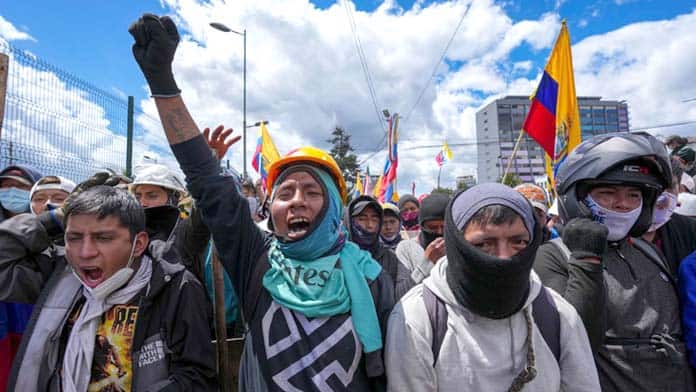Indigenous protests in Ecuador have won major concessions after a general strike that brought the capital Quito and the port city of Guayaquil to a standstill for 18 days in June. Protesters blockaded roads, occupied key government buildings and used targeted sabotage to disrupt fossil fuel infrastructure.
The effects of COVID hit Ecuador particularly hard—a disastrous government response saw over 35,700 deaths, whilst economic mismanagement has seen suffocating inflation and household income drop by an average of 40 per cent at the height of the COVID crisis. Over 60 per cent are jobs outside agriculture are in the informal sector, including street vendors and taxi drivers.
Since taking office, Ecuador’s right-wing President Guillermo Lasso, a former banker and businessman, has furthered the economy’s decades-long embrace of neoliberalism.
This has only exacerbated the extreme inequality within the country. With markets now slowly crumbling, Lasso has created an impossible situation for many Ecuadorians, but none more so than the primarily agricultural, already impoverished Indigenous population.
Sonia Guamangate, an Indigenous woman who joined the protests by travelling from Samanga in the Cotopaxi region, explained how economic pressure has driven her community to breaking point:
“The prices have risen in the city, but what we get paid for our agricultural products remains the same. Sometimes they are paying as little as $5 or $6 for 100 kilograms of potatoes. That’s a year’s work for some of us. They call us ignorant Indians. We are not ignorant. We supply the food for the city.”
Primarily led by the Confederation of Indigenous Nationalities of Ecuador (CONAIE) and joined by a multitude of unions and student groups, the movement was quickly and brutally targeted by government forces, who labelled the protest as an attempted coup, declared a state of emergency, sought to arrest CONAIE leaders, and authorised police to use deadly force to disperse protesters.
However after the actions of the protesters caused significant food shortages in Quinto and Guayaquil, Lasso narrowly avoided both a motion of no confidence and impeachment and the government finally broke on June 30, agreeing to most of CONAIE’s demands, including:
- the suspension of the state of emergency
- the reduction in the price of a gallon (five litres) of petrol and diesel by 15 cents
- the prohibition of mining in protected areas and ancestral territories, as well as in archaeological and water protection zones
- support for immediate delivery of medicines and supplies to hospitals and health centres
- raising the human development bonus from $50 to $55
- a fertiliser subsidy.
This signifies a major victory for CONAIE and its allies, staring down a defiant neoliberal government with little interest in providing any form of relief to its citizens in the midst of a severe cost of living crisis.
Cycle of revolt
In recent years mass protests have shaken a series of Latin American countries, including Chile, Haiti and Puerto Rico. New left-wing leaders have also been elected in Chile, Colombia and Peru, in a region ravaged by US imperialism and neoliberal austerity.
This is not the first time that CONAIE and its allies have forced major change to Ecuador’s political landscape through mass protest.
Formed in the mid-1980s, CONAIE has engaged in a series of mass uprisings alongside labour and urban neighbourhood allies.
However it has continually put its trust in electing left-wing governments that have betrayed it. A major uprising in 2000 toppled a President who had sought a deal with the IMF.
After the following election CONAIE led another uprising against the new President, after backing him at the election. The left-wing governments of Raffael Correa and his successor Lenin Moreno also proved a disappointment.
In 2019 CONAIE staged another mass national strike against the supposedly left-wing leader Moreno. This won a victory forcing the abandonment of a major austerity package including attempts to cut fuel subsidies.
But it then called off the protests, out of concern a more right-wing leader might be the result. This meant that instead of pushing for the working class and poor to take power themselves, the existing parliamentary system remained intact and the government survived.
After the protests were called off, the right won the subsequent elections.
The movement has now entered a 90-day negotiation period with President Lasso in exchange for halting the current protests.
The example set in Ecuador shows how mass protests and strikes can win real, tangible victories over the cost of living and inequality. But real fundamental change cannot come through working to elect different leaders within the existing state—the movement from below has to take power for itself.
By Joshua Look






